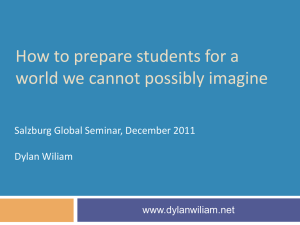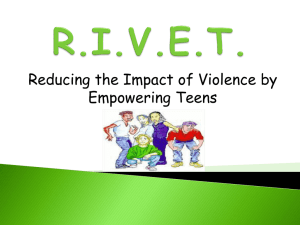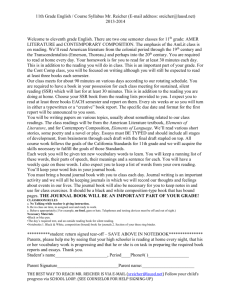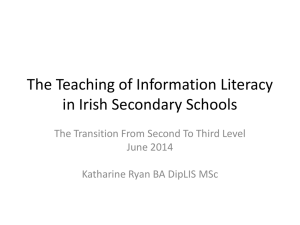Second Step Violence Prevention Program
advertisement
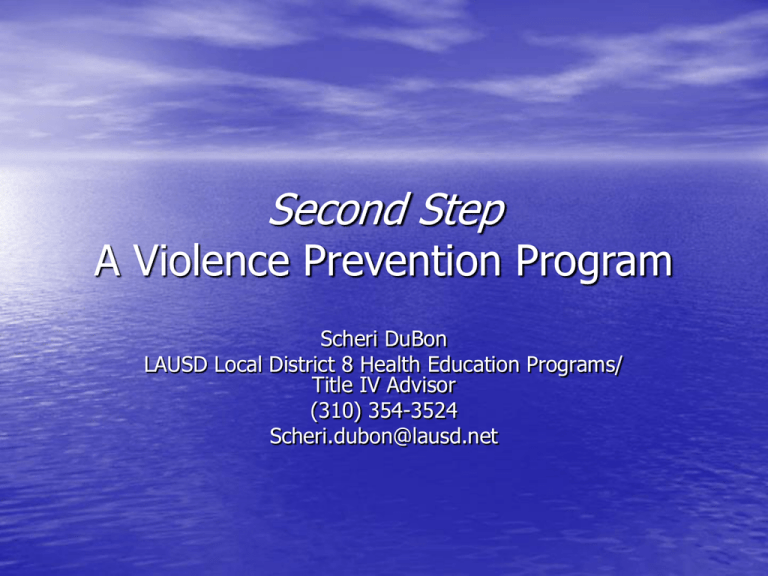
Second Step A Violence Prevention Program Scheri DuBon LAUSD Local District 8 Health Education Programs/ Title IV Advisor (310) 354-3524 Scheri.dubon@lausd.net Second Step Training Goals To help staff understand what it means to use a social skills approach to youth violence prevention. To prepare staff to use Second Step curriculum with students. Why did LAUSD choose Second Step? Meets Federal and State Mandates Only violence prevention curriculum rated as exemplary by the United States Department of Education Most widely used. Universal curriculum In addition to being “Teacher Friendly” Safety and Learning Correlation Closing the Achievement Gap District Goals Developmental Assets Brain Research Safety and Learning Correlation between level of perceived safety and API scores Teaches students how to mediate their emotions so they can calm down and get back to learning Closing the Achievement Gap Ensure that “disagreements are handled with discussion and with respect for alternative positions” “promote respect for the uniqueness of each person as well as for the ways we are similar” AEMP/Closing the Achievement Gap Branch, 2004 District Goals Improved student achievement in English Language Arts Improved student achievement in Math Successful and timely re-designation of EL students Improved attendance rates Improved graduation rates Focused and coherent professional development Developmental Assets See Handouts Based on success not failure Not a curriculum Second Step promotes 31 of the 40 Assets Brain Research “Students must feel physically safe and emotionally secure before they can focus on the curriculum.” David A. Sousa How The Brain Learns, 2001 What the Bleep Do We Know!? Safety in our Schools “ Trying to create a safe school climate without teaching students social-emotional skills is like trying to educate our students without teaching them to read.” Kevin Dwyer School Psychologist National Expert on School Safety Reasons Children Fail to Act Prosocially Lack of modeling Lack of practice Desired behavior inhibited by emotional responses Inappropriate beliefs about aggression Skill Based Program: PreK-8 Based on research showing that people who engage in child abuse, domestic violence, and other kinds of criminal behavior lack the following skills: Empathy Impulse Control Problem Solving Anger Management Empathy Students are taught to: Understand the feelings of others Understand points of view that are different from theirs Respect all people regardless of differences Treat others with kindness Impulse Control Students are taught to mediate their emotions by: Learning to identify their feelings Learning how to interrupt their automatic reactions through calming down techniques Practice these skills in a variety of challenging social-emotional situations Problem-Solving Students are taught to solve problems in ways that are: Safe Fair Take into account everyone’s feelings Will work Anger-Management Students are taught to: Identify where in their bodies they feel angry Interrupt the anger cycle through calming down methods Use positive problem-solving methods Assess how well they handled their anger Implementation See Handouts Scope and Sequence Lesson Teaching Time Guidelines Lesson Section Breakdown Social Skills Teaching Strategies See handout Modeling Coaching and Cueing Storytelling Group Discussion Role-Play Facilitation* Transfer of Learning Resources Committee for Children www.cfchildren.org Developmental Assets www.search-institute.org Unit Review Activity Unit Card What is the goal of your unit? What key elements are taught in your unit? What language concepts are taught in your unit? What Transfer of Learning ideas or Extension Activities Ideas would you use?



